You'll find that the shift from foraging to farming stemmed from a mix of climate changes and the need for stable food sources. After the Ice Age, fertile areas like the Fertile Crescent emerged, attracting early humans. Resource scarcity from overhunting pushed communities to explore agriculture, initially growing wild grains. As people settled, agricultural innovations allowed for surplus food and trade, transforming social structures. Yet, this new lifestyle brought health risks and sparked resistance, as many still valued the foraging way of life. To uncover more layers of this fascinating evolution, keep exploring the details behind this monumental change.
Key Takeaways
- Climate change post-Ice Age made formerly inhospitable regions fertile, prompting the search for stable food sources.
- Resource scarcity from overhunting increased the demand for reliable food supplies, leading to agricultural practices.
- The Fertile Crescent's rich soil provided ideal conditions for early farming, supporting population growth and agriculture's rise.
- Early innovations in plant and animal domestication enhanced food security, enabling settled communities and trade networks.
- Social hierarchies emerged as land ownership developed, influencing wealth distribution and labor specialization in farming societies.
Historical Context of Foraging
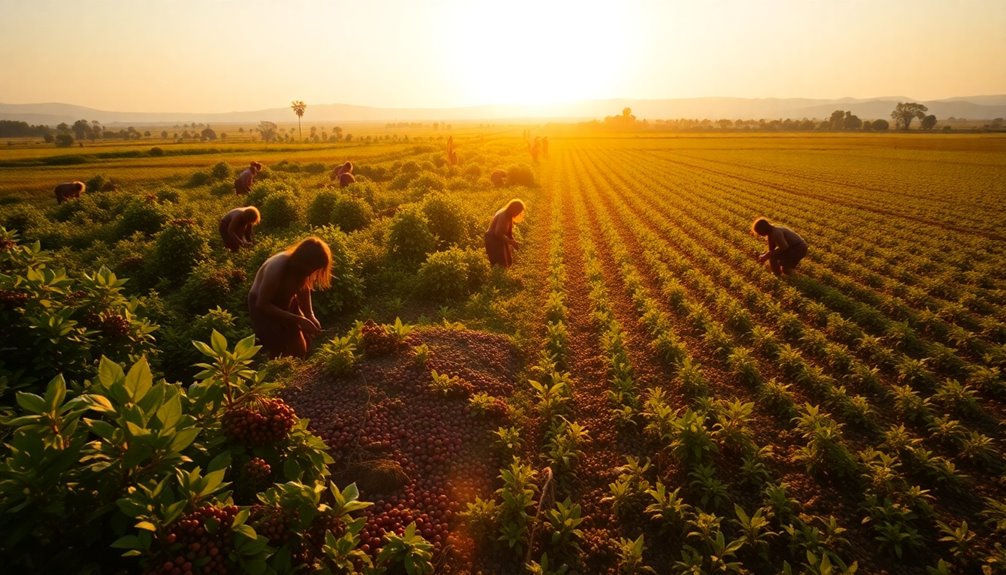
For over 100,000 years, humanity's survival hinged on foraging and hunting, shaping our ancestors' way of life. During this extensive period, humans relied on gathering wild plants and hunting animals, creating a diverse diet that supported their nomadic existence.
Initial foraging practices were rich and varied, allowing for the consumption of numerous food sources, which helped sustain small, mobile communities.
As the Neolithic era approached, around 12,000 years ago, a significant shift to agriculture began. Early farming methods emerged alongside the exploitation of wild grains, which had been gathered and consumed for thousands of years. This change marked a pivotal moment in human history, as foraging practices gradually diminished in favor of more settled agricultural lifestyles.
While foraging provided a wealth of nutrients, it also required constant movement in search of resources. As populations grew, so did the pressure on these wild plants, leading to a gradual adaptation to farming.
The complex social structures and cultural practices developed by foragers laid the groundwork for future societies, setting the stage for the profound changes that agriculture would bring.
Environmental Factors Influencing Change
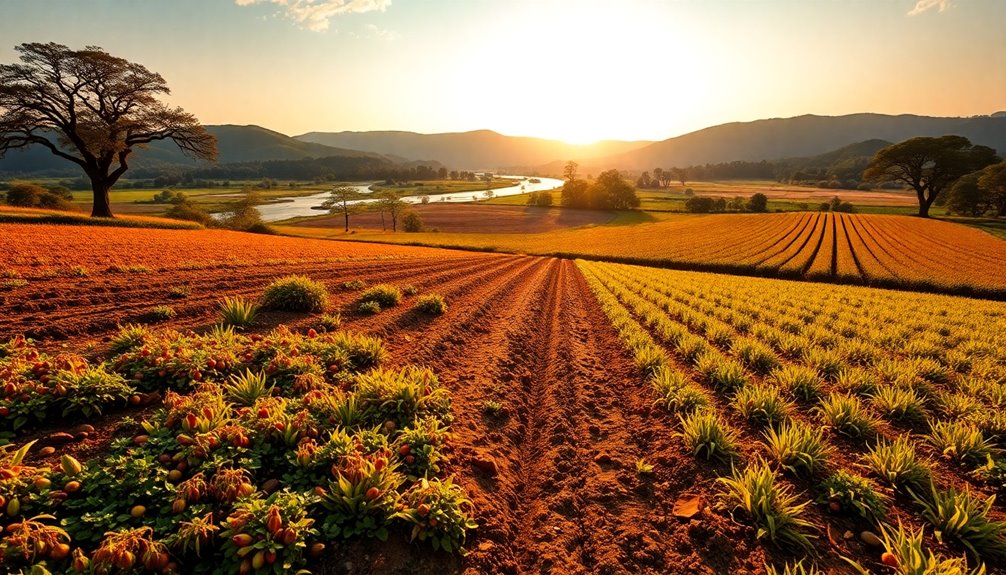
As climate change transformed the landscape after the Ice Age, regions once deemed unsuitable for farming became fertile and inviting. This shift created opportunities for early humans to explore new ways of securing food. Resource scarcity, driven by overhunting and environmental changes, pushed communities to seek more stable food sources. This necessity led to a significant change from foraging to farming.
Several key environmental factors influenced this shift:
- Fertile Crescent: This region offered ideal conditions for agriculture, with rich soil and a favorable climate that encouraged the growth of various crops.
- Population Growth: As communities expanded, the demand for a reliable food supply increased, prompting a move toward agricultural practices to sustain larger populations.
- Agricultural Innovations: In response to environmental pressures, humans developed techniques like the domestication of plants and animals, which enhanced food security and improved resource management.
Together, these factors created a compelling case for early humans to embrace farming, marking a pivotal shift in human history. This change laid the groundwork for modern civilization as we understand it today.
Initial Agricultural Practices
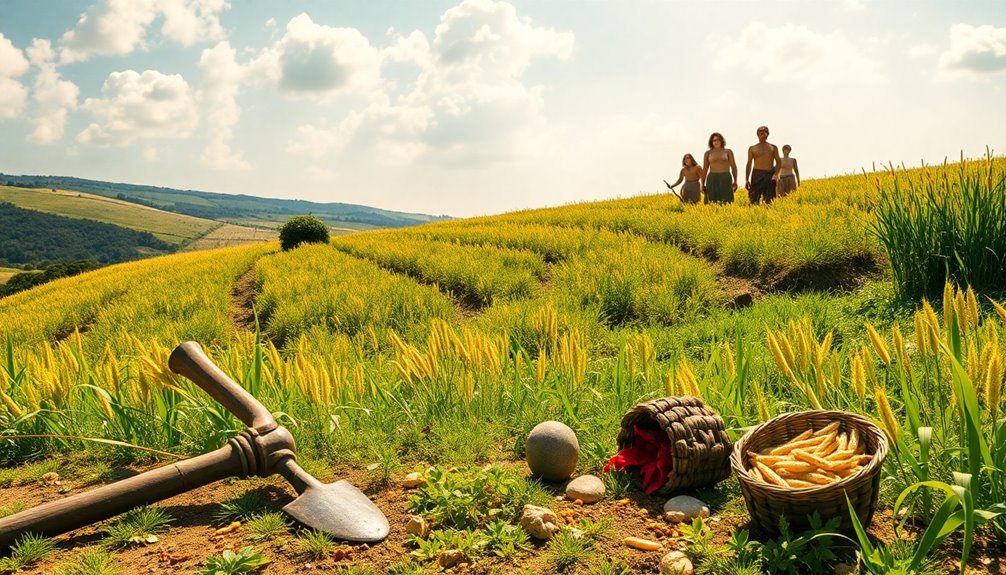
The shift from foraging to farming kicked off with early humans gathering and planting wild grains, setting the stage for a transformative agricultural revolution. These initial agricultural practices marked a significant change in human lifestyle, as societies began to rely on domesticated crops like wheat and barley. This reliable food source allowed communities to settle and grow, laying the foundation for modern civilization.
Early farming techniques utilized simple tools and methods, such as hand planting and harvesting. While less productive than later advancements, these methods were essential in establishing the groundwork for agriculture. Additionally, the creation of irrigation systems enhanced water availability, particularly in arid regions, supporting crop growth.
Here's a breakdown of some early agricultural practices:
| Early Agricultural Practices | Description |
|---|---|
| Gathering | Collecting wild grains and seeds |
| Planting | Sowing seeds in prepared soil |
| Hand Harvesting | Manually collecting mature crops |
| Irrigation | Directing water to crops |
| Settled Communities | Establishing permanent living spaces |
This gradual shift to farming unfolded over generations, showcasing humanity's adaptability to new agricultural methods.
Social and Economic Impacts
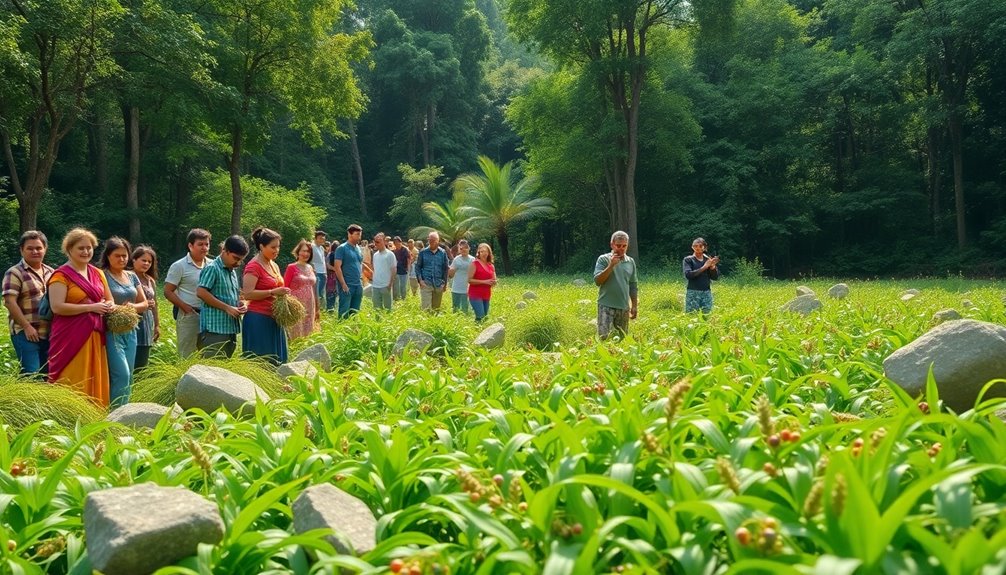
A significant shift from foraging to farming transformed social and economic structures in early human communities.
You'd notice that surplus food production allowed for trade, leading to the emergence of market networks. This newfound abundance didn't just fill bellies; it reshaped how people interacted.
- Social Hierarchies: As agricultural practices flourished, land ownership became a key factor in wealth accumulation. This created distinct social hierarchies as some individuals controlled more resources than others. Furthermore, the rise of agriculture led to a decrease in mobile lifestyles, as people began to settle in one place. This shift contributed to increased emotional volatility within communities, as interpersonal relationships became more intense and complex. Additionally, this increase in population density often necessitated the development of renewable energy sources to support growing communities.
- Permanent Settlements: Farming supported the establishment of permanent settlements, which in turn facilitated larger populations. This increased density fostered more complex social dynamics and governance structures.
- Labor Specialization: With surplus food, people could pursue various professions beyond agriculture. Labor specialization emerged, enhancing economic complexity and innovation within communities.
Additionally, these changes allowed for the development of complex social dynamics, leading to richer cultural exchanges and societal growth.
Resistance to Farming Adoption
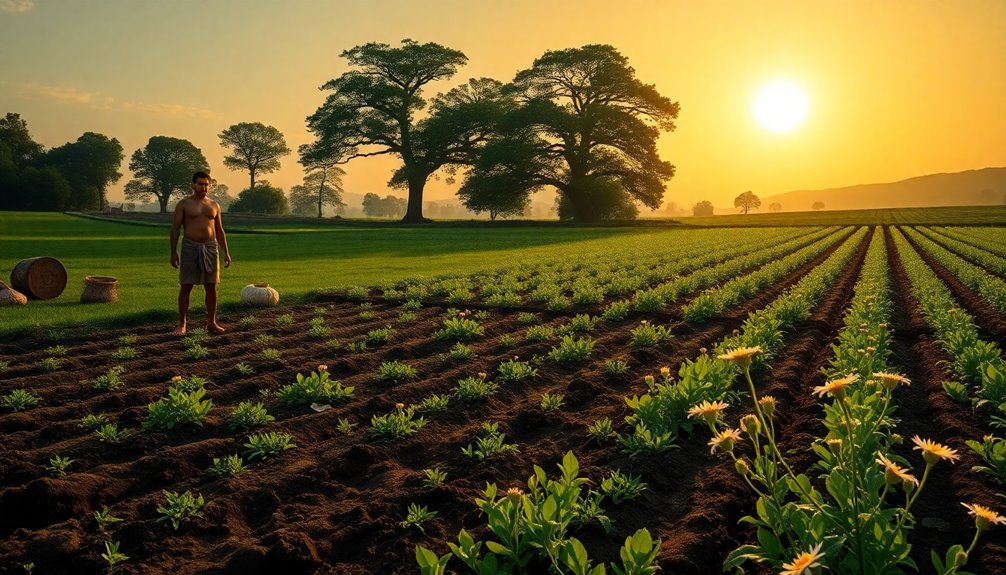
You might find that many communities resisted farming due to health concerns linked to early agricultural practices.
The fear of poor nutrition and weakened bones made foraging seem like a safer option.
Additionally, a strong cultural connection to traditional foraging may have further fueled this reluctance to switch to farming.
Health Concerns
Health concerns played a significant role in the resistance to farming adoption among early human populations. Many foragers perceived their lifestyle as not only sufficient but also healthier compared to the emerging farming practices. The shift to agriculture brought about notable health issues, leading many to hesitate in making the switch.
- Reduced Dietary Diversity: Farming often resulted in reliance on a few domesticated crops, leading to malnutrition and vulnerability to food shortages. Foragers enjoyed a varied diet that supported better overall nutrition.
- Increased Disease Transmission: Dense populations in farming communities made it easier for diseases to spread. Living closely together facilitated the transmission of pathogens, making people wary of adopting such lifestyles.
- Health Problems: Evidence from skeletal remains indicates that the introduction of farming correlated with a decline in health, including osteoarthritis and dental issues. The stability provided by agriculture came with significant health trade-offs.
These factors contributed to a cautious approach toward farming, as many early humans valued their foraging lifestyle, which seemed to better support their health and nutrition needs. Furthermore, the historical context of emotional dysregulation in response to these changes may have influenced societal attitudes toward adopting new agricultural practices.
Cultural Attachment to Foraging
Historically, many Northern European hunter-gatherer groups often clung to their foraging traditions, viewing them as a reliable source of sustenance. This cultural attachment to traditional foraging practices created a strong reluctance to embrace the change to farming.
You can imagine how deeply rooted these lifestyles were; established social structures and knowledge systems revolved around hunting and gathering techniques that had been passed down through generations.
For many, the perception that foraging provided sufficient food reduced their motivation to change. After all, early agricultural methods often led to negative health outcomes, such as poor nutrition and unhealthy bones.
Why would you want to adopt a system that could jeopardize your well-being? The shift to farming represented not just a change in diet, but a significant behavioral shift that increased labor and introduced dietary limitations.
Moreover, the immediate benefits of agriculture weren't always apparent. When you weigh the proven success of foraging strategies against the uncertainties of farming, it's clear why some groups resisted this new lifestyle.
The comfort of tradition held strong, making it challenging to abandon a way of life that had long served them well.
Archaeological Insights and Discoveries
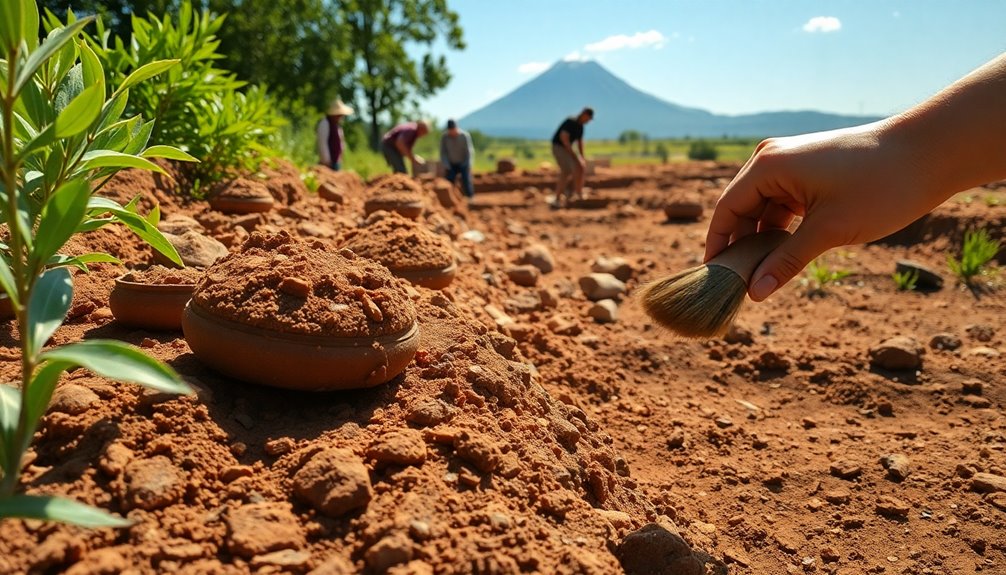
As recent archaeological discoveries reveal, the shift from foraging to farming wasn't a sudden event but a gradual change marked by significant social and cultural developments. Excavations in the Azraq Basin of Jordan uncovered long-term hunter-gatherer settlements, challenging the notion that these groups were merely transient.
You'll find that these findings highlight several key aspects of early human history:
- Sedentary Lifestyles: Sites like Kharaneh IV, occupied for 1,200 years, revealed stone tools and oval hut structures, suggesting that hunter-gatherers would establish more permanent communities.
- Cultural Sophistication: Analysis of over 1,400 skeletons showed sophisticated burial practices, including emotional ties to animals through joint burials, indicating a complex social structure.
- Gradual Agricultural Practices: Discoveries of wild grain exploitation, dating back 14,500 years, suggest that the behavioral shifts leading to farming communities were more gradual, possibly starting as early as 19,000 years ago.
These archaeological insights paint a detailed picture of how hunter-gatherers engaged with wild plants and animals, setting the stage for the eventual rise of farming in human history. Additionally, the development of community engagement in agricultural practices can be observed as societies began to form around shared resources and farming techniques.
Future Research Directions

Recent archaeological findings illuminate the complexity of early human societies, paving the way for future research directions that promise to deepen our understanding of the change from foraging to farming. One key area of focus is uncovering earlier agricultural practices, which suggest humans may have cultivated plants as far back as 19,000 years ago. This timeline challenges previous beliefs and invites a reevaluation of how early communities adapted to farming.
Future research will also explore the behavioral complexities associated with this gradual change from foraging. Investigating the environmental factors, including climate change and resource scarcity, will be essential to understanding how these elements influenced early human societies.
Additionally, researchers plan to examine the social structures of farming communities, looking at property rights and group dynamics that facilitated the adoption of agriculture.
Moreover, the integration of mathematical models in archaeological studies will enhance our comprehension of the dynamics of early agricultural societies. These models will help simulate group sizes, conservatism, and the spread of agricultural innovations, providing insights that will shape our understanding of this transformative period in human history.
Frequently Asked Questions
What Caused Humans to Shift From Foraging to Farming?
You might wonder what caused humans to shift from foraging to farming. This change occurred as populations grew and resources became scarce.
Warmer climates after the Ice Age made new areas suitable for agriculture. You'd notice that by domesticating plants and animals, communities could rely on consistent food sources.
This shift led to permanent settlements and the development of social structures, fundamentally changing how humans lived and interacted with their environment.
Why Did the Transition From Foraging to Farming Occurred in the Nile Valley?
Picture a lush oasis where the Nile flows like a lifeline. You see fertile soil and predictable floods, beckoning you to cultivate crops.
Around 10,000 years ago, you find that growing emmer wheat and barley offers a stable food supply, unlike the uncertainty of hunting. As the climate warms and irrigation techniques emerge, your community flourishes, leading to organized societies and trade.
This vibrant transformation from foraging to farming reshapes your world forever.
Why Did We Shift From Food Foraging to Food Production?
You shifted from food foraging to food production mainly to secure a reliable food supply.
As populations grew, you faced challenges like resource scarcity. Warmer climates made farming viable, allowing you to cultivate crops and domesticate animals.
This change provided a more stable diet, despite early farming's lower productivity and nutritional drawbacks.
Why Did People Stop Foraging?
When the rubber hit the road, people started to realize that relying on foraging wasn't cutting it anymore.
Scarcity of resources due to overhunting and environmental changes left you craving a more stable food supply.
With rising populations and a warmer climate, you found fertile land that made farming a viable option.
Innovations like seed planting and animal domestication offered you dependable food, transforming your lifestyle and paving the way for settled communities.
Conclusion
As you reflect on humanity's journey from foraging to farming, it's clear this shift was fueled by a blend of environmental changes and social dynamics. Like a seed planted in fertile soil, these early innovations blossomed into complex societies. Understanding this transformation not only reveals our past but also reminds us of our resilience and adaptability. Embrace the lessons of history, as they still guide us in steering through the challenges of today's world.










